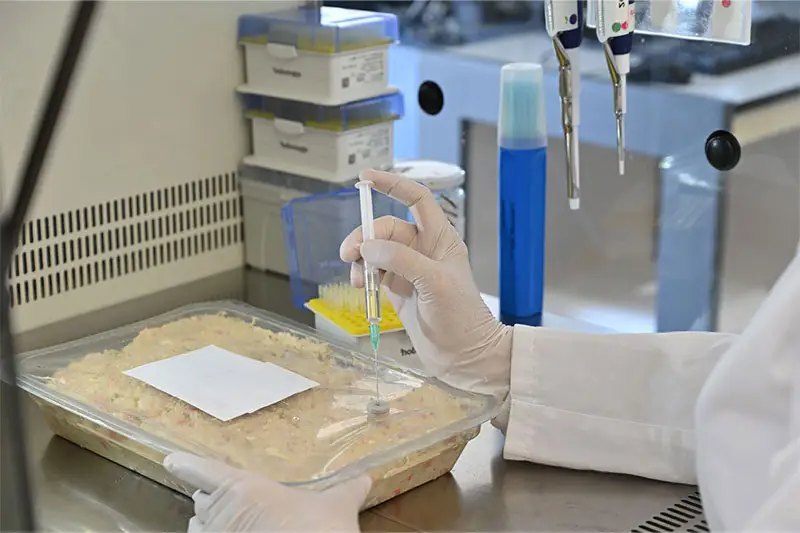Microbial Challenge Testing in Cosmetic Packaging
In the highly regulated world of cosmetics, ensuring product safety and microbial stability is paramount. Microbial challenge testing (MCT) for cosmetic packaging plays a critical role in safeguarding consumer health by evaluating how effectively packaging materials can prevent the growth or entry of microorganisms into products. This form of testing ensures that the chosen packaging material provides an adequate barrier against contamination, thereby maintaining product integrity and safety.
The process involves inoculating various types of bacteria, yeast, and mold onto a cosmetic product within its package, then incubating it under controlled conditions to observe any microbial growth or penetration. The efficacy of the packaging is assessed by quantifying the number of viable microorganisms after exposure time. This method not only helps in identifying potential weak points but also aids in optimizing packaging design to enhance shelf life and safety.
For quality managers, this testing ensures that cosmetic products meet stringent regulatory requirements like those set forth by FDA and EMA. Compliance officers benefit from knowing the packaging's performance in preventing microbial contamination, which is critical for maintaining product quality. R&D engineers can leverage these test results to refine their formulations and designs, ensuring that new products not only comply with regulations but also offer superior safety features.
Microbial challenge testing in cosmetic packaging is particularly important given the high moisture content typical of many cosmetics, such as lotions, serums, and creams. These conditions can foster microbial growth if proper packaging isn't employed. By conducting this test, manufacturers can identify whether the packaging effectively inhibits microorganisms or if additional measures are necessary to ensure product safety.
Understanding the specifics of MCT is essential for procurement teams as they evaluate suppliers and materials. The results from these tests help in selecting the most suitable packaging that meets both regulatory standards and consumer expectations regarding hygiene and safety.
Benefits
The benefits of microbial challenge testing for cosmetic packaging extend beyond mere compliance; they contribute significantly to enhancing product quality, consumer trust, and overall market success. By implementing this rigorous test methodology, manufacturers can:
Ensure regulatory compliance with international standards such as ISO, ASTM, and IEC.
Minimize the risk of product recalls due to microbial contamination.
Elevate brand reputation by demonstrating a commitment to consumer safety and quality.
Safeguard against potential lawsuits related to product defects or health issues.
Optimize packaging design for maximum protection, which can enhance shelf life and stability of the products.
Demonstrate transparency in communication with consumers about the safety measures implemented during production.
In summary, microbial challenge testing is an indispensable tool that empowers cosmetic manufacturers to produce safer, higher-quality products, thereby fostering long-term customer satisfaction and loyalty.
Industry Applications
| Application Area | Description |
|---|---|
| Spray Bottles | Evaluating the integrity of spray nozzle openings to prevent microbial ingress. |
| Jars and Containers | Testing the sealability and barrier properties against microorganisms for products like serums. |
| Pumps and Droppers | Assessing the closure systems' ability to retain product integrity during use. |
| Lipsticks and Glosses | Safeguarding the lip contact area from microbial contamination by ensuring proper packaging design. |
| Creams and Lotions | Ensuring that the high moisture content does not lead to microbial growth within the container. |
| Application Area | Description |
|---|---|
| Finger-Pressed Squirts | Testing for potential breaches in the packaging that could allow microorganisms to enter. |
| Dispensers and Bottles | Evaluating the risk of contamination from reapplication or prolonged use. |
| Gelatin Capsules | Assuring the sterility of gelatin-based products by testing packaging integrity. |
| Solid Lotions | Making sure that the packaging protects against microbial entry without compromising product texture. |
The diverse range of applications underscores the importance of MCT in ensuring the safety and efficacy of all cosmetic products, regardless of their form or function. By addressing potential risks early in the development process, manufacturers can significantly reduce the likelihood of issues arising post-launch.
Environmental and Sustainability Contributions
Evaluating the environmental impact of microbial challenge testing involves considering both the direct effects on packaging materials and the broader implications for sustainable practices. Packaging that effectively prevents microbial contamination can reduce waste by extending product shelf life, thereby minimizing the need for frequent replacements or reorders.
Moreover, using eco-friendly materials in MCT ensures that the testing process aligns with sustainability goals. This includes selecting biodegradable packaging and reducing the amount of material used without compromising on safety and efficacy. By adopting sustainable practices, cosmetic manufacturers can contribute to a greener supply chain, which is increasingly important for consumer preference and regulatory expectations.
Additionally, microbial challenge testing helps in minimizing waste by identifying optimal packaging designs that maximize product protection while minimizing environmental footprint. This approach not only supports sustainability but also enhances the overall reputation of brands committed to environmental stewardship.





